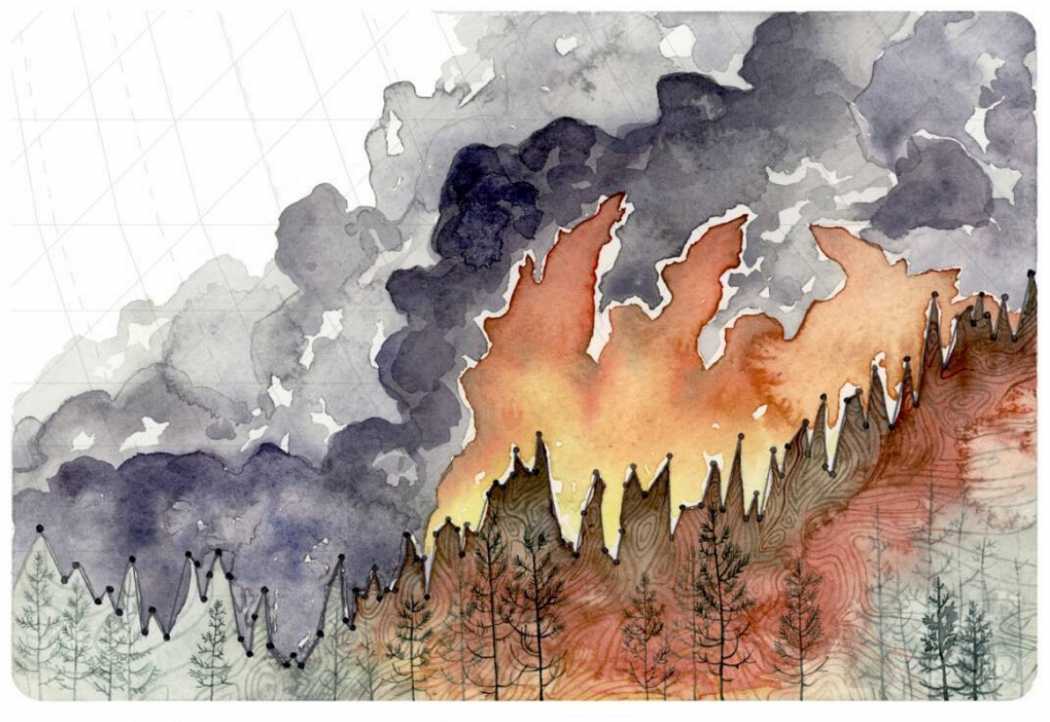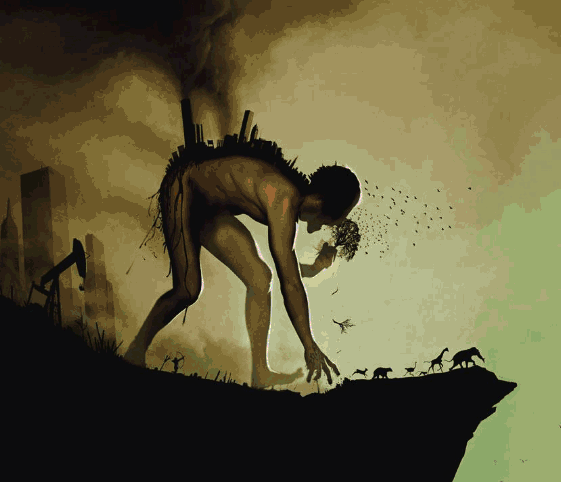 (‘Increasing Forest Fire Activity‘ (watercolor and colored pencil) by climate-change artist, Jill Pelto).
(‘Increasing Forest Fire Activity‘ (watercolor and colored pencil) by climate-change artist, Jill Pelto).
Beyond the pressing business of political ugliness, our weather is still taking a climate-changing whiplash. Although today here in California’s Central Valley was again full-on sunshine and warm, the eastern US was a freezing, snowbound madhouse — the climate crisis is bad not only because of the horrific heat, but also the horrific cold.
From CNN this evening:
CNN meteorologist Jennifer Gray writes about the cold in the Northeast this week: “It’s the kind of cold capable of delivering frostbite in minutes, turn boiling water into frozen mist in a nanosecond, and even cold enough to freeze your eyelashes.”
But it’ll feel even colder than that. With wind chill, it will feel like minus 60 degrees Fahrenheit on summit peaks in Vermont.
…
Experts told CNN’s Ramirez that bold action to cut emissions could actually lead the Earth to cool in the second half of this century. But she writes the course right now, according to the watchdog Climate Action Tracker, is for the world to blow past 1.5 degrees Celsius over pre-industrial levels, up to 2.4 degrees of warming or more.
Surely, if climate disasters get worse and more frequent, countries will snap to attention. Right?
Not necessarily, you would think that instead of drinking your own urine to fight COVID, you’d take three easy shots (fully-vaxxed, booster) to make life a bit easier. But no.
And the bat-shit crazy has become obvious in the weather — the earth is cooking:
?2021 was 5th warmest year on record. The last 7 years have been the warmest years on record by clear margin, says @CopernicusECMWF
WMO will issue consolidated ranking, based on all the major international datasets, later in Januaryhttps://t.co/BNCQzjYlX9#ClimateChange pic.twitter.com/LKD3mfSNBZ— World Meteorological Organization (@WMO) January 10, 2022
Heat in the air — from the Guardian this morning:
The last seven years were the world’s hottest on record, with the first analysis of global temperature in 2021 showing it was 1.2C above pre-industrial levels.
The assessment of the year, by the European climate agency Copernicus, also found carbon dioxide in the atmosphere reached record levels and that the potent greenhouse gas methane surged “very substantially,” also to a new record.The rise in greenhouse gas concentration means more heat is being trapped than ever before but 2021 ranked as the fifth hottest year on record.
This is because a natural and cyclic climate phenomenon called La Niña exerted a cooling influence by bringing cold Pacific waters to the surface.The climate crisis continued unabated with extreme weather striking across the world.
Europe suffered its hottest summer on record and broke its maximum temperature record in Sicily with 48.8C, while intense wildfires raged in Italy, Greece and Turkey.
Severe floods made up to nine times more likely by global heating also wreaked havoc in Germany and Belgium.Extreme heat also caused the “mother of all heatwaves” in the west of the US and Canada. Temperature records were smashed by 5C and scientists calculated the event was made at least 150 times more likely by global heating.
In California, the Dixie wildfire was the second largest in history.China’s meteorological agency recently announced that 2021 was the country’s hottest year on record and that its northern region had its wettest year, with extreme weather widespread.
Floods in July in Henan province caused hundreds of deaths.Mauro Facchini, the head of Earth observation for the European Commission, said: “The 2021 analysis is a reminder of the continued increase in global temperatures and the urgent necessity to act.”
The Copernicus data shows 21 of the 22 hottest years have come since the year 2000.“The [extreme weather] events in 2021 are a stark reminder of the need to change our ways, take decisive and effective steps toward a sustainable society,” said Carlo Buontempo, director of the Copernicus climate service.
Yeah right, change our ways?
Plus beyond the CO2, methane emissions have also increased as I noted last week, and it’s worse:
Methane levels are accelerating with the growth rate in 2021 approximately three times the rate of a decade ago. Methane is emitted through fossil fuel exploitation, cattle and other livestock, and natural wetland processes and scientists are uncertain about the cause of the rapid rises.
Vincent-Henri Peuch, at Copernicus, said: “CO2 and methane concentrations are continuing to increase year-on-year and without signs of slowing down.
Prof Rowan Sutton, at the University of Reading, UK, said: “At a global level the warming may appear gradual but it is the impact on extreme events in many different parts of the world that is dramatic. We should see the record breaking 2021 events, such as the heatwave in Canada and floods in Germany, as a punch in the face to make politicians and public alike wake up to the urgency of the climate emergency.”
Tell that to the rich:
Without stronger #climateaction, the five biggest emitters will double the number of countries regularly experiencing extreme hot years by 2030. #globalwarming #extremeheat #COP26 https://t.co/Gf74ydqDE3
— ETH Zurich (@ETH_en) January 7, 2022
We’re fat-catting our role in the climate crisis and we’ll make the rest of the world be sucked into the environmental disaster coming and is now here all the more worse.
Although a new study reveals nothing new on climate change, other than to reinforce the rule that the rich say f*ck off to the poors — if the world’s biggest emission producers don’t slow down and get a handle on their outpour the world will heatedly suck, especially for everybody.
From ETH Zurich last week:
The emissions of just five economies, China, the US, the EU, India and Russia, over the period 1991-?2030 will double the number of countries experiencing extreme hot years every second year by 2030, according to a new scientific paper published today in Communications Earth and Environment.
The results highlight the outsized role these emitters play in driving warming and temperature extremes around the world.The study led by scientists at ETH Zurich and Climate Analytics looks at the impacts of these top five emitters over two periods: 1991-?2030, and 2016-?2030, over which they will contribute 52-percent and 53-percent of global emissions respectively.
Under current emissions reductions targets, 92percent of all countries are expected to experience extreme hot years every second year by 2030, twice as many countries as without the 1991-?2030 emissions from the top five polluters (46-percent).
Notably, 15-percent of this increase would be attributable to the emissions of these five economies between 2016-?2030 – after the Paris Agreement was signed.
“Our work shows that over a relatively short time period the emissions of these five economies have a strong impact on extreme heat experienced around the globe by 2030. We’re talking about annual mean temperatures that would only be experienced once every 100 years in pre-?industrial times happening every second year”, said ETH Zurich researcher Lea Beusch, lead author of the study.
…
The study comes in the wake of the COP26 Glasgow Climate Pact that requests countries to revisit their 2030 climate targets to align them with the Paris Agreement temperature goal of 1.5°C global warming above pre-?industrial levels.“Our results underscore that the actions of the world’s top emitters will have a huge impact for our global temperature trajectory in this decade. How they respond to the COP26 outcome will be fundamental to whether 1.5°C stays within reach — none of their targets are currently sufficient”, says Alexander Nauels of Climate Analytics, who coauthored the study.
Maybe some weather CGI will help, no wait this is real shit here — tornadoes last month:
Once again, here we are…
 (Illustration out front found here).
(Illustration out front found here).